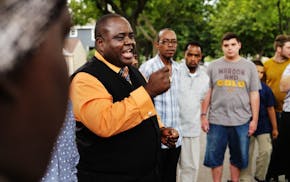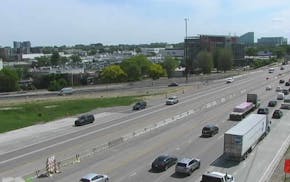Downtown Minneapolis boosters like to call Nicollet Mall "Minnesota's Main Street." But I can't say those words with a straight face these days.
Nicollet Mall's empty storefronts have become a sad centerpiece of downtown, which otherwise boasts many great attractions — from the historic central riverfront to plentiful theaters and stadiums.
Minneapolis Mayor Jacob Frey wants to remove the buses to revive the street. I think the city should be focused on something more mundane: Doors. We need more of them.
Nicollet Mall is what happens when a city — over generations — prizes big retail and spacious corporate lobbies over small-scale storefronts. If we want more people on Nicollet Mall, we need to chop up the ground-level spaces so that small businesses can plausibly occupy them.
We should all care about the mall's future, since this is how many visitors first encounter our region when they travel here for conventions and major events.
The mall is also important for the region's tax base, since taxes paid by the surrounding office towers are a foundation of the city's budget and spread to the rest of the metro through our innovative tax sharing program. A healthy Nicollet Mall could help reverse nosediving downtown building values.
Ever the salesman, Frey in last year's budget address envisioned a bus-less Nicollet Mall with ice rinks, ice bars, ziplines, dog parks and a Ferris wheel.
But to make a great street, you need permanent stuff to do there that brings people back day after day — long after the ice bar has melted.
Think small
I first heard Nicollet Mall's problem framed in terms of doors a decade ago, during a walking-oriented tour of local architecture with then-consultant Sam Newberg. He advocated for a door every 25 feet, and we admired the tiny storefront at Medical Arts Building (now Come Pho Soup restaurant).
"There should be more opportunities for that," he said. "Whether it's a tiny flower shop — even a newsstand can probably do business here."
The same concept arose at that time in my conversations with former columnist Barbara Flanagan, a Nicollet Mall devotee.
"You should think No. 1 in terms of stores," she said in 2015. "They put up some business buildings that took away the store spaces. But you could put them on the ground floor."
After the mall was reconstructed, Barbara grew more frustrated. "Where are the stores?" she asked me in 2018, the year she died. "That's what's so dumb about it. They rebuilt the Nicollet Mall and there are no stores!"
Walking around the mall today, it feels like the buildings are just waiting for big retail to return.
Look at the fledgling Dayton's Project, for example, where they can't find tenants to occupy a gargantuan former department store. City Center's sizable spaces are now boarded up. The glassy mall-facing retail spaces of IDS Center are all empty. I can count five restaurants that have cycled through a multistory space near 9th Street and Nicollet in the last decade.
I am told that retrofitting storefronts will be expensive and a tricky sell, partly since many of the building owners aren't based here. It would also require a significant public-private partnership. Additional work would then be needed to entice small businesses. A 2023 report from the Minneapolis Foundation, "Downtown Next," offers some strategies to address these hurdles.
And there are some potential sources of funding to incentivize the changes.
The city is redirecting about $6 million a year in taxes from certain buildings to a special "value capture" district that was supposed to pay for a streetcar on Nicollet and Central avenues. (The streetcar project is now dead, and a slight change in state law would loosen up that money.) City leaders are also considering a new 2% tax on hotel stays, which would generate about $6 million a year toward things that help boost tourism.
Opaque windows
While we're talking about storefronts, the city should get serious about another more basic problem that hurts the vitality of the mall: Windows.
The city has long had special rules for Nicollet Mall buildings, saying that their ground-level facades must have a lot of transparency. After all, seeing inside businesses makes cities more enjoyable to walk around. These rules have since been extended to much to downtown.
Yet the norm has become for Nicollet Mall businesses that are open to hide activity behind opaque windows or other coverings, contributing to the general blandness of the street.
The city's planning director, Meg McMahan, said they have a small staff of zoning inspectors who address these issues based on complaints — and they aren't receiving complaints about Nicollet Mall windows. Perhaps we need to start filing some.
Should the buses go?
I'm struggling with the proposal to remove buses from the mall, which was endorsed in the "Downtown Next" report.
There is something backwards to me about trying to improve a street's vitality by removing roughly 12,000 people who use transit there every day. This is, after all, why Nicollet Mall was intentionally constructed in the 1960s as a "transit mall" — because buses bring people there.
A group of riders took the city to court to stop the change. The city's pedestrian advisory committee says the alternative streets are unsafe and less convenient. The city says the change will speed up the buses.
I could see a bus-less mall becoming eerily quiet, apart from the occasional shrieks of a zipliner overhead. Over coffee recently at Corner Coffee (a great small shop on the mall), I asked Downtown Council President Adam Duininck about what happens if the buses leave.
He hopes to boost the amount of planned activities happening on the mall, and see more retailers take advantage of the roomy sidewalks. He said buses are dampening the number of sidewalk cafes.
"This coffee shop we're sitting in should have a plaza out here," Duininck said.
The buses are admittedly loud. A beer at the News Room would be more enjoyable if they weren't idling and releasing exhaust nearby. I would like to hear more discussion of how to make them quieter (such as electric buses or trolleybuses).
I'm hoping we can discuss this and other ideas to improve the mall in a future column. The mall also needs more greenery, bathrooms and programming — to name a few themes that have surfaced in conversations. Email me your thoughts at eric.roper@startribune.com, or fill out the form below to be featured in a live blog session next Tuesday from 11:30 a.m. to 1 p.m.
You can follow this column by email by signing up here. A newsletter is forthcoming.
Worried about the future? We predict you'll read this story about a high-profile St. Paul astrologer

Head of violence interruption program in Twin Cities charged with stealing $150,000 in employee wages
Police identify victim of homicide on St. Paul's West Side

